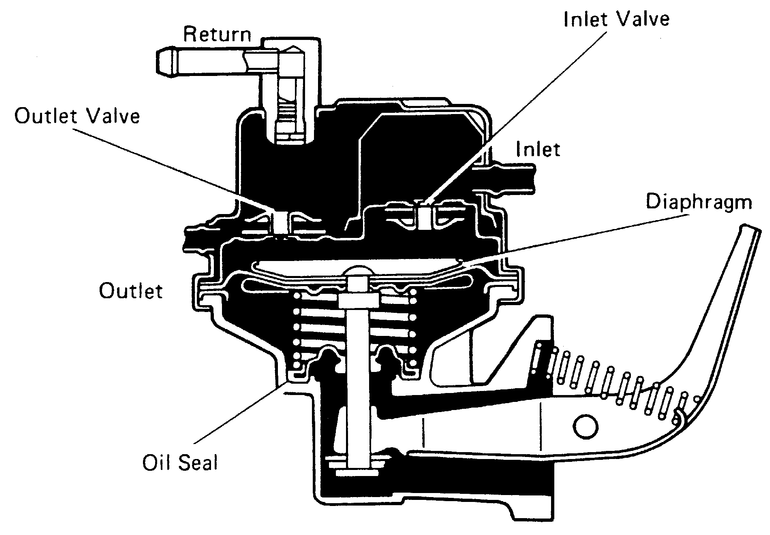Supercharging Small Engines with Vacuum Fuel Pumps

Is your small engine struggling to keep up? Could it use a boost in performance and reliability? Integrating a vacuum fuel pump might be the solution you're looking for. This seemingly small modification can have a significant impact on how your small engine operates, particularly in demanding conditions or with older equipment.
Fuel delivery is the lifeblood of any engine, and small engines are no exception. Traditional gravity-fed systems can sometimes falter, especially when dealing with steep inclines, prolonged use, or fuel lines that have seen better days. A vacuum fuel pump provides a consistent and reliable fuel supply, ensuring your engine gets the fuel it needs, when it needs it.
The concept of augmenting fuel delivery with a vacuum-assisted pump isn't new. While historically more common in automotive applications, the benefits of a vacuum fuel pump installation on small engines have become increasingly recognized. This shift is driven by the demand for more powerful and reliable small engines in everything from lawnmowers to generators.
One of the core advantages of incorporating a vacuum fuel pump lies in its simplicity. These pumps leverage engine vacuum to operate, eliminating the need for complex electrical wiring or additional power sources. This streamlined design contributes to both ease of installation and reduced maintenance.
However, integrating a vacuum fuel pump into a small engine isn’t without its potential pitfalls. Incorrect installation or improper pump selection can lead to issues ranging from poor performance to engine damage. Understanding the nuances of vacuum fuel pump selection and the specific requirements of your engine is paramount for a successful upgrade.
Vacuum fuel pumps operate on the principle of pressure differential. The engine's intake manifold creates a vacuum, which is then used to draw fuel from the tank and deliver it to the carburetor. The pump itself contains a diaphragm that responds to the vacuum fluctuations, creating a pumping action.
One key benefit of installing a vacuum fuel pump is improved fuel delivery consistency, especially under load. This is particularly helpful for equipment used on inclines or for extended periods. A second advantage is enhanced cold-starting performance, as the pump helps prime the carburetor with fuel. Finally, a vacuum fuel pump can extend the life of the fuel system by reducing strain on other components.
Before fitting a vacuum fuel pump, ensure compatibility with your engine. Next, locate a suitable mounting point near the engine and fuel tank. Connect the fuel lines securely, paying close attention to the direction of fuel flow. Finally, test the system for leaks and proper operation.
Advantages and Disadvantages of Adding a Vacuum Fuel Pump
| Advantages | Disadvantages |
|---|---|
| Improved fuel delivery | Potential vacuum leaks |
| Enhanced cold starting | Incorrect installation can cause issues |
| Simplified fuel system maintenance | May not be necessary for all small engines |
Best practices include choosing a high-quality pump, using appropriate fuel lines, ensuring a secure mounting location, and performing regular checks for leaks or damage. Real-world examples include applications in lawnmowers, generators, pressure washers, and go-karts. Common challenges include vacuum leaks, diaphragm failure, and fuel line blockages, all of which can be addressed with proper troubleshooting.
Frequently asked questions often revolve around compatibility, installation procedures, troubleshooting, and maintenance. Tips and tricks include using a fuel filter to prevent blockages and regularly inspecting the pump diaphragm for wear and tear. Additional information can be found in small engine repair manuals and online forums.
In conclusion, incorporating a vacuum fuel pump can significantly enhance the performance and reliability of a small engine, particularly in demanding situations. While careful planning and execution are crucial for a successful installation, the benefits of improved fuel delivery, easier starting, and reduced fuel system strain often outweigh the potential challenges. By understanding the principles of operation, following best practices, and addressing potential issues proactively, you can unlock the full potential of your small engine and ensure its smooth operation for years to come. Taking the time to research and properly install a vacuum fuel pump is a worthwhile investment for anyone looking to maximize the performance and lifespan of their small engine equipment.
Transform your kitchen with gray cabinet paint by benjamin moore
Unlocking electronics your guide to circuit symbol diagrams
Gone too soon hollywood mourns recent losses













